The Unknown Maradona
And the 1986 World Cup
@Asim Deb
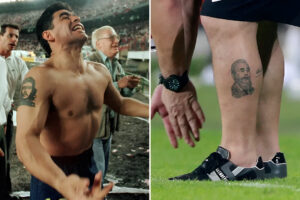
Maradona’s respect and love for the revolutionary personalities were reflected on his tattooed body, of Che Guevara on his right arm and Fidel Castro on his left leg. His connection to Cuba went beyond admiration; he was personally close to both Fidel and Raúl Castro and received medical treatment there several times. In a strange twist of fate, Maradona died on November 25, 2020 — the same date Castro passed away in 2016, and also the anniversary of George Best’s death, in 2025.
Most Fouled Player in FIFA World Cup History
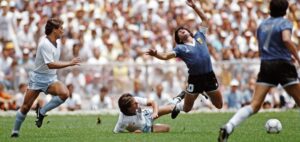
In the 1982 FIFA World Cup in Spain, Italy fouled him 23 times in a single match in Barcelona — still the record for the most fouls suffered by any player in a single FIFA World Cup game. During the 1986 World Cup in Mexico, Maradona was the main target of every defense that Argentina faced — and he had to pay the price. He was fouled 53 times over the course of the 1986 FIFA World Cup tournament, a record that still stands. In the quarter-final alone, against England at the Estadio Azteca in Mexico City, he was brought down repeatedly despite scoring two of the most iconic goals in World Cup history.
Maradona Hosted Pelé on His First Talk Show Episode
 In 2005, Maradona launched 2 hour talk shows of 12 episodes on Argentine TV called La Noche del 10. For his very first episode, he invited Pelé — a surprising move, considering their well-known rivalry. The two legends kept things friendly, shared stories, and even bounced a ball between them using only their heads — a brief but memorable moment between two of the game’s greatest.
In 2005, Maradona launched 2 hour talk shows of 12 episodes on Argentine TV called La Noche del 10. For his very first episode, he invited Pelé — a surprising move, considering their well-known rivalry. The two legends kept things friendly, shared stories, and even bounced a ball between them using only their heads — a brief but memorable moment between two of the game’s greatest.
Maradona, a recovering cocaine addict, talked about drugs with Pele, whose son has been jailed for drugs offences. He looked slim and healthy after an operation to staple his stomach, aimed at cutting his ballooning weight. Fellow Argentine footballer Gabriel Batistuta, the country’s leading international goal scorer, and tennis star Gabriela Sabatini joined Pele for Maradona’s first programme.
Pele praised Maradona for offering an example of how to beat addiction, “You are an example for him because you are a conqueror,” he said. “Your programme is going out to the world, and I think together we can do many things in the world to help a lot of people.”
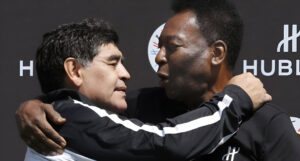
In the series, most guests were drawn from the worlds of football and show business, including Rinaldo, Zinedine Zidane, and also notable friends and personalities such as Cuban leader Fidel Castro, boxer Roberto Durian and Mike Tyson. The last night’s premier by the soccer great-turned-television host was to feature Argentine tennis star Gabriela Sabatini and Italian actress Maria Grazia Cucinotta. Maradona also had invited heartthrob singer Diego Torres and the leading Argentine national team scorer of all times, Gabriel Batistuta, for what he said would be the first in a regular series as his variety show gets under way this season for local network Canal 13. Maradona gave each of his guests a signed Argentina jersey, which Tyson wore when he arrived in Brazil, Argentina’s rivals in football.
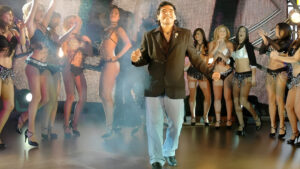
Insiders say, Channel 13 needed to boost its ratings in the fight against Telefe, its main competitor. It bet on a star like Diego Armando Maradona to fight for the top spots. The gamble paid off: the number 10 donned his TV host’s uniform and faced the cameras just like he used to do on the pitch, dodging opponents and performing wonders with the ball. Sergio Goycochea, the goalkeeper who had saved him in the 1990 World Cup, was his coaching partner.
Argentina has a Church in Diego Maradona’s Name
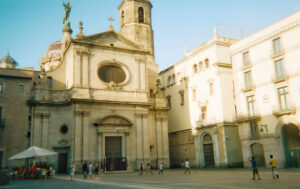
In 1998, a group of Maradona fans in Rosario, Argentina, founded the Iglesia Maradoniana (the Church of Maradona).
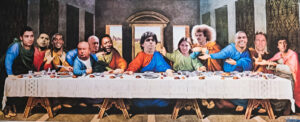
It treats his birthday, October 30, as its New Year, and followers track time using “D.D.” (Después de Diego – “After Diego”). So in their calendar, the year 2020 was 60 D.D., marking what would’ve been his 60th birthday. The church reportedly has over 300,000 members worldwide, all united in celebrating Diego as a football divinity.
FIFA’s ‘Goal of the Century’
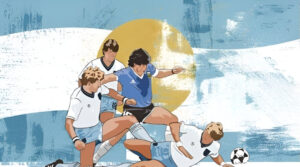 During the 1986 World Cup quarter-final against England, just minutes after the infamous Hand of God goal, Maradona scored what many at that time considered the greatest goal in football history. He picked up the ball in his own half, dribbled past five England players in 11 seconds, and beat goalkeeper Peter Shilton to make it 2–0.
During the 1986 World Cup quarter-final against England, just minutes after the infamous Hand of God goal, Maradona scored what many at that time considered the greatest goal in football history. He picked up the ball in his own half, dribbled past five England players in 11 seconds, and beat goalkeeper Peter Shilton to make it 2–0.
In a 2002 FIFA fan poll, this goal was officially named the “Goal of the Century”. As a tribute, a statue of Maradona capturing that exact moment was installed at the entrance of Mexico City’s Estadio Azteca — the very place where he pulled it off.
First Player to Set the World Record Transfer Fee Twice
Diego Maradona’s exceptional talent commanded unprecedented transfer fees during his career. In 1982, FC Barcelona acquired him from Boca Juniors for a then-world record fee of £5 million (approximately €7.3 million). Two years later, in 1984, SSC Napoli surpassed this by signing Maradona from Barcelona for around £6.9 million (about €7.8 million). At the time, these fees were unheard of. Both transfers made headlines across the football world, and in Naples, he paid every cent back.
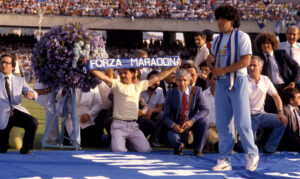
Led Napoli to Their First-Ever Serie A Titles
Before Maradona arrived in 1984, Napoli had never won a Serie A title. Their best finishes were second place in 1968 and 1975, and the only trophies in their cabinet were two Coppa Italia wins. That dry-run changed with Diego when he led them to their first Scudetto in 1986–87, a season they also won the Coppa Italia, and again in 1989–90. Under his leadership, Napoli also lifted their only European trophy: the 1989 UEFA Cup.
After years of ups and downs, including relegations and financial collapse, the club finally won a third Serie A Title in 2023, — 33 years after Maradona’s last triumph. Today, his legacy still echoes in Naples, with murals across the city and a stadium that now bears his name.
Five Children with Three Different Women
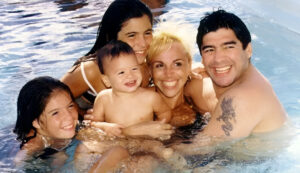 Maradona officially had five children with three different women — at least, that’s what was publicly confirmed for most of his life. He had two daughters, Dalma and Gianinna, with his ex-wife, Claudia Villafañe. During his time at Napoli, he fathered a son, Diego Jr., with Italian model Cristiana Sinagra, though he didn’t acknowledge him until years later. In 1996, he had a daughter named Jana with Valeria Sabalain, and in 2013, he had a son, Diego Fernando, with Verónica Ojeda. Later on, Maradona admitted to having several more children, including at least three in Cuba. By the end of his life, he had recognized eight children in total, though some reports claim the real number may be higher.
Maradona officially had five children with three different women — at least, that’s what was publicly confirmed for most of his life. He had two daughters, Dalma and Gianinna, with his ex-wife, Claudia Villafañe. During his time at Napoli, he fathered a son, Diego Jr., with Italian model Cristiana Sinagra, though he didn’t acknowledge him until years later. In 1996, he had a daughter named Jana with Valeria Sabalain, and in 2013, he had a son, Diego Fernando, with Verónica Ojeda. Later on, Maradona admitted to having several more children, including at least three in Cuba. By the end of his life, he had recognized eight children in total, though some reports claim the real number may be higher.
Maradona & Pelé Shared the FIFA Player of the Century Award.
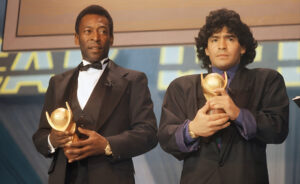 In 2000, FIFA decided to name a “Player of the Century” to mark the turn of the millennium. An internet poll was launched, and Maradona ran away with it, winning over 50% of the public vote — more than double Pelé’s count. But FIFA, reportedly uncomfortable with Maradona’s controversial image and wanting to honor both eras of football, added a separate vote by a panel of experts That panel voted for Pele. In the end, FIFA gave the award to both. Maradona accepted it with pride, while Pelé later said, “If he thinks he’s the best player of the century, that’s his problem.”
In 2000, FIFA decided to name a “Player of the Century” to mark the turn of the millennium. An internet poll was launched, and Maradona ran away with it, winning over 50% of the public vote — more than double Pelé’s count. But FIFA, reportedly uncomfortable with Maradona’s controversial image and wanting to honor both eras of football, added a separate vote by a panel of experts That panel voted for Pele. In the end, FIFA gave the award to both. Maradona accepted it with pride, while Pelé later said, “If he thinks he’s the best player of the century, that’s his problem.”
It was the perfect ending to one of football’s most debated rivalries — two giants, forever linked, forever compared.
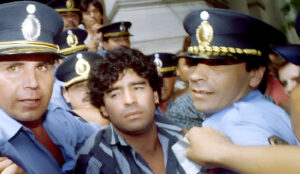 Maradona leaves a courthouse in March 1994 after answering charges of shooting and injuring journalists outside his country home in Mercedes, 100km from Buenos Aires.
Maradona leaves a courthouse in March 1994 after answering charges of shooting and injuring journalists outside his country home in Mercedes, 100km from Buenos Aires.
Photograph: Stringer/Argentina/Reuters
Maradona and his 1986 FIFA World Cup would be remembered for Ever,
Maradona was 25 years old and entering the prime of his career when the 1986 World Cup came around. He had broken the world transfer record for the second time by joining Napoli from Barcelona for £6.9 million in 1984, and helped the Serie A side finish eighth and then third after they had narrowly avoided relegation the season before he signed. The next campaign, immediately after the World Cup, they won the Scudetto for the first time in their history and then added the Coppa Italia.
In 1986 World Cup, England had finished second in their group and beaten Paraguay in the round of 16 to qualify for the quarter-finals, while Argentina were unbeaten and had seen off Uruguay to book their place in the last eight. Having already built up a traditional footballing rivalry, four years earlier the two countries had been at war for the Falkland Islands.
The Falkland Island added enough fuel in the tension to what was always likely to be a friendly sportying and fiery game. Maradona lined up behind Jorge Valdano in Argentina’s 3-5-1-1 formation, while England played a fairly narrow 4-4-2 with Steve Hodge and Trevor Steven furthest wide in the midfield.
The first half passed without any goals, though Peter Beardsley had a very good chance for England. The Argentine superiority in the second half, for very different reasons, gets into the history of the World Cup.
For the second goal, Maradona received the ball just inside the Argentina half. Taking a first touch towards his own goal to evade one opponent, he then found himself in the face of another and rolled the ball back to spin away towards the right touchline. With some space to run into, he then sped away from Peter Reid in pursuit as he crossed the halfway line.
Gradually cutting inside towards the England box, Terry Butcher came out to meet him but could only swing a desperate leg in Maradona’s vague direction as he checked further into the middle of the pitch. Now approaching the edge of the area, a stationary Terry Fenwick never had a chance of stopping the 5′ 5″ man in top speed hurtling towards him and simply tried to foul Maradona before he could advance on Shilton. No luck.
Maradona had one more player to beat; Shilton himself. Anticipating a shot into the far corner, the goalkeeper went to ground and Maradona dragged the ball past him with his left foot exactly as he had done with Fenwick before placing into the empty net despite Kenny Sansom clattering him from behind. English Manager Bobby Robson, however, could have no complaints about the second. “A brilliant goal,” he added. “I didn’t like it but I had to admire it.”
After a match like that, Argentina had to go all the way. Maradona scored twice to secure a 2-0 win over Belgium in the semi-finals and West Germany beat France by the same margin to book their first trip to the Estadio Azteca of the tournament.
The Germany coach, Franz Beckenbauer, set Lothar Matthaus to man mark Maradona and on the surface, it appeared to work – having scored all four of his team’s goals in the quarter-final and semi-final, Maradona was held off the scoresheet. His influence, though, was still felt. First, he won the free-kick from which Jose Luis Brown headed home to give the South Americans the lead. Shortly after half-time, he played a part in the move which led to Valdano making it 2-0 at the end of a quick break upfield. West Germans were a stubborn, hardworking team, however, and seemed to have salvaged extra time through goals from Karl-Heinz Rummenigge and Rudi Voller, both from left-sided corners. But Maradona was not quite done. With six minutes to play, he opened his body up to receive a bouncing ball with three German players surrounding him and spotted the run of Jorge Burruchaga, who sprinted away from Hans-Peter Briegel and slotted past Harald Schumacher in goal.
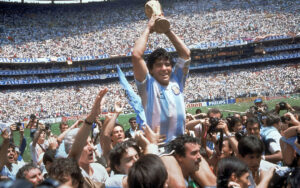 Argentina became the World Champions again.
Argentina became the World Champions again.
At the end, on Maradona’s death, the Argentine government declared three days of mourning. “You took us to the highest point of the world, and made us immensely happy,” President Alberto Fernandez said. “You were the greatest of all. Thank you for having been with us, Diego. We will miss you all our lives.”
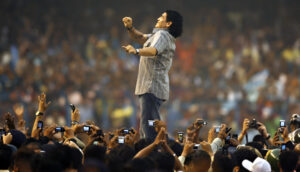
Source: FIFA website. BBC,
https://www.youtube.com/watch?v=-ZrdMQKo4Zw
https://www.footballdive.com/2025/04/02/10-interesting-facts-about-diego-armando-maradona-you-need-to-know/#:~:text=But%20the%20worst%20came%20before,in%20one%20World%20Cup%20game.
https://en.mercopress.com/2005/08/16/maradona-and-pele-launch-talk-show
******

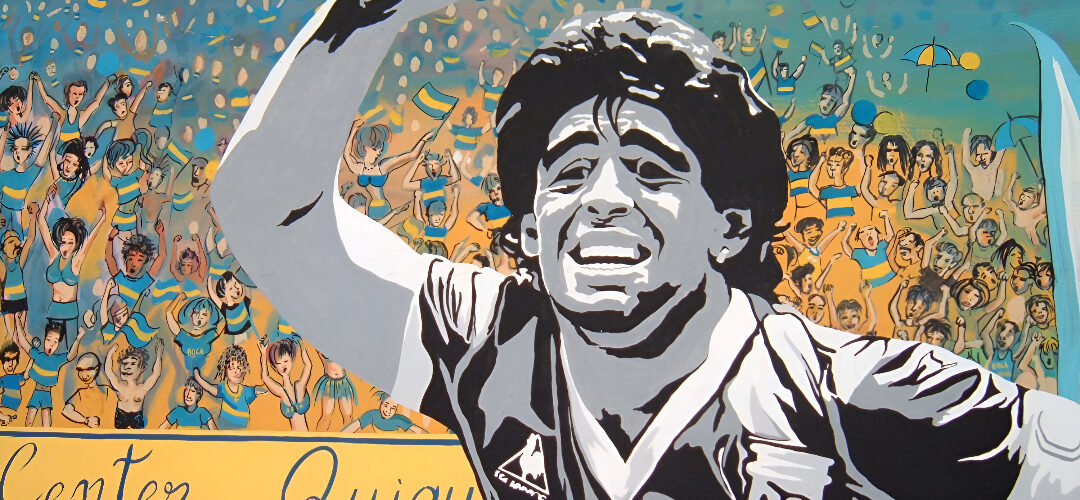
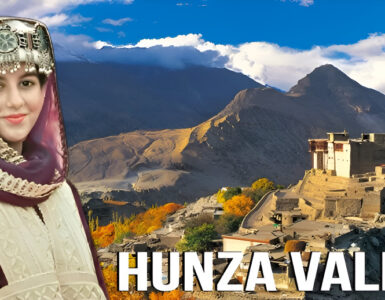
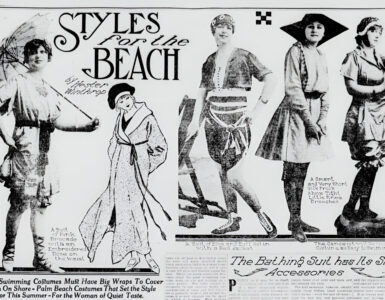
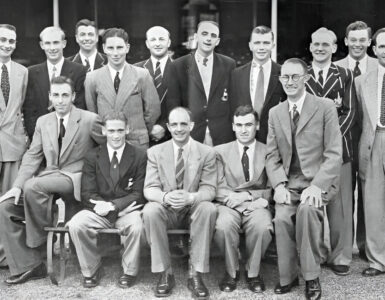









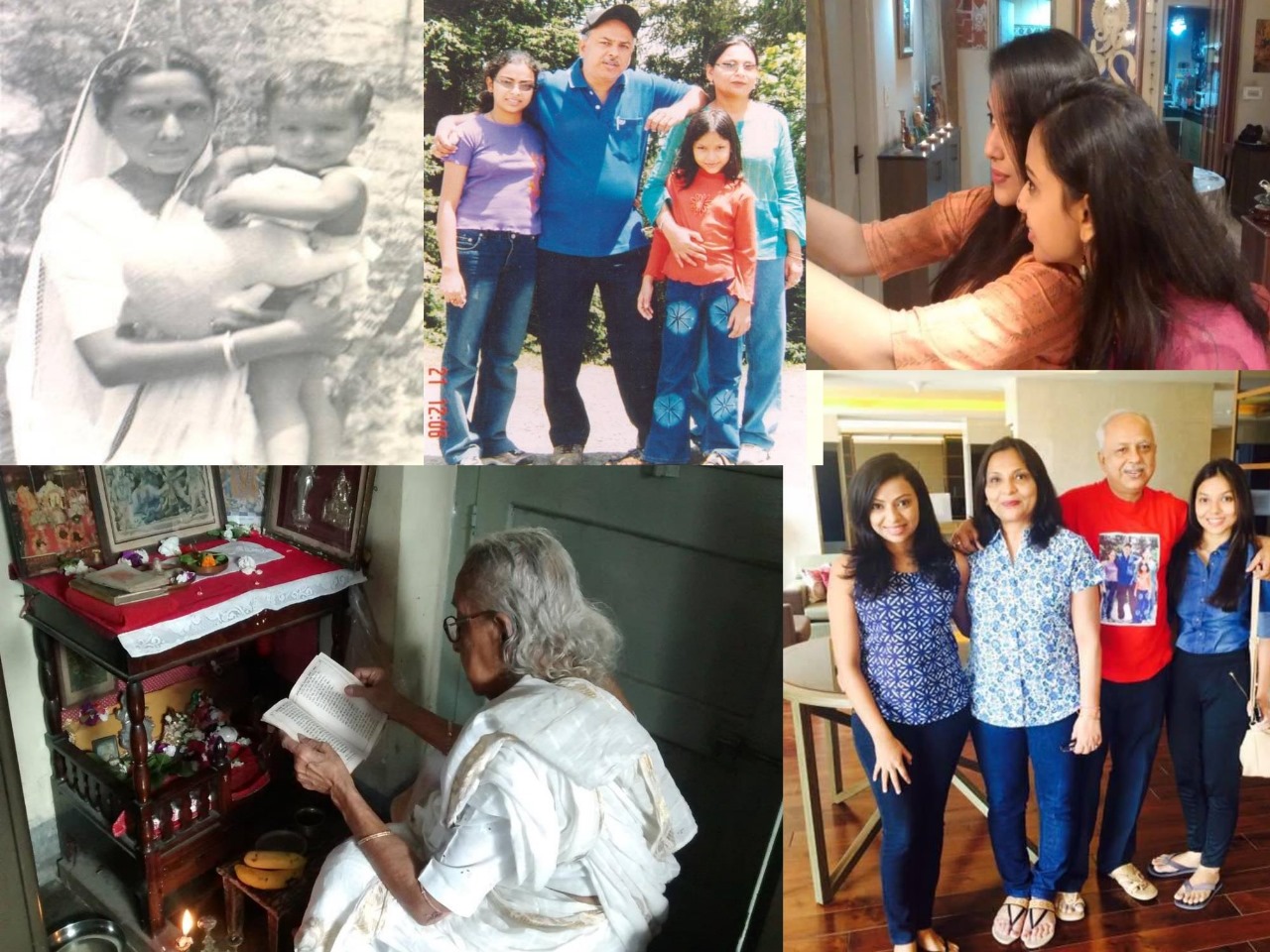
I had watched the much talked about Argentina vs England WC Football match in 1986 when the Hand of God goal was scored by Maradona against England. It was a controversial goal no doubt,given the non existance of VAR technologies then.But the second goal scored by Maradona was a classic example of skill and talent and remain forever in the history of football.